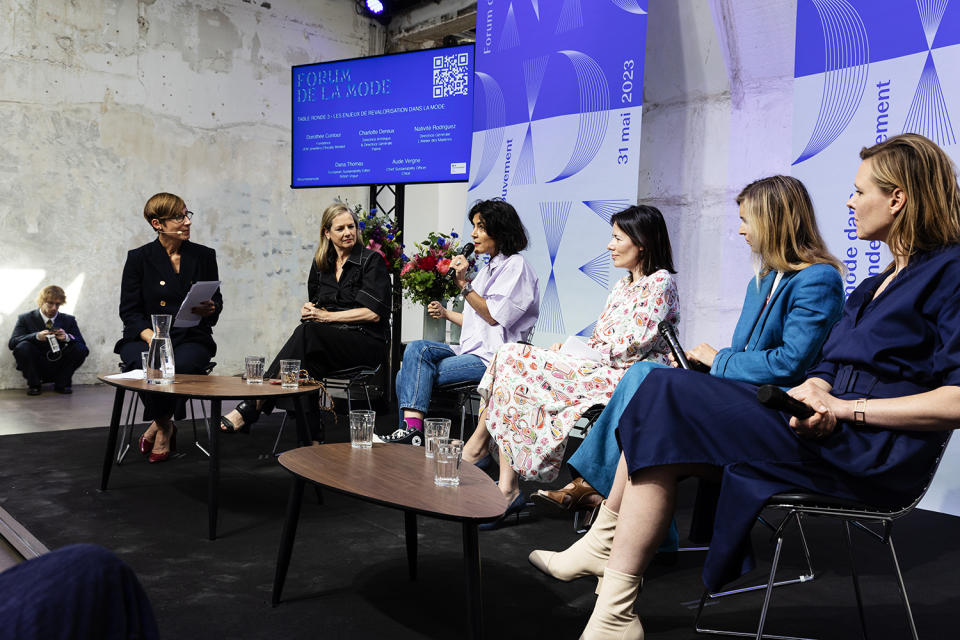French Fashion Forum Considers What Comes Next for the Industry

PARIS — “The value of fashion is 5 euros,” said Yann Rivoallan, president of the Fédération du Prêt-à-Porter Féminin, or French federation of women’s ready-to-wear, at the Forum de la Mode, or Fashion Forum, on Wednesday.
The fashion executive, who is also president of the Everywhere Anytime vocational school dedicated to technology, was taking part in the opening keynote of a sixth edition dedicated to “The Value of Fashion in a World in Movement,” alongside Pascal Morand, executive president of the Fédération de la Haute Couture et de la Mode, and Institut Français de la Mode’s general manager Xavier Romatet.
More from WWD
While that amount represented the price of a T-shirt on ultra-fast fashion giant Shein, Rivoallan offered other figures, such as 5 million people shopping on secondhand resale platform Vinted; 500 million, the number of clothes still in good condition exported to Africa, or 50 billion, the number of TikTok videos talking about Shein.
And “we haven’t seen anything yet,” he was quick to add, noting that the advent of AI will bring further fundamental shifts. To Rivoallan, the rights and respect of workers, innovation with sober consumption in mind and traceability were among the paths to solving the riddle of fashion’s future value.
Morand said the real question was how to define and quantify what “value” is, offering readings that went from the philosophical to so-called hard sciences.
“These are real topics that condition public policy and how private and public actors can harmonize,” he continued, pointing out that the industry found itself at a particular juncture of the technological, digital and ecological revolutions.
With the fashion and luxury sectors representing some 150 billion euros in France, or some 2.7 percent of the country’s GDP — more than the automotive and aviation industries combined — Romatet said fashion had “a major dimension to weigh on absolutely necessary evolutions” like ecological transition.
“That’s why France must lead the impetus for change,” he continued, citing the polarization toward either luxury or entry-level prices and changes in buying behavior among the industry’s current mutations.
“We will only find answers through innovation, of course, but most of all, in education and training, a fundamental pivot in behavior,” he said, highlighting the “market inversion” of secondhand fashion, which had grown from 1 billion to 6 billion euros I the space of five years, driven by consumer price concerns and desire for responsible purchases.
The importance of fashion and consumers’ choices as political ones was highlighted the first roundtable of the day. Echoing Romatet’s earlier comment about “voting with one’s credit card,” journalist and author Mélody Thomas said “clothing has symbolic value beyond a consumer product, as long as consumers realize who made them, what they’re wearing and what image the brand carries.”
On deep societal issues such as reproductive rights, diversity and inclusion, Thomas said that “it’s not visible support but transparency” that is the key for brands.

This is particularly important as “we are today in a world of symbols and signs. Even a brand that would decide to have no image positioning and only create clothes would be seen as [making] a statement and appeal to the ecologically committed consumers,” said fashion critic and doctoral candidate at the École des Hautes Etudes en Sciences Sociales research institution Saveria Mandella.
Another key to the future for fashion was its heritage, but on the condition that it be leveraged into new creations and with innovation in mind, with Patou’s artistic director Guillaume Henry likening patrimony to a conversation shared between stakeholders and generations. “A house that lasts [does so] because its characteristics are transmitted from one designer to the next,” he said.
In the age of “permanent buzz,” Julien Tuffery, third generation and chief executive officer of denim manufacturer and brand Atelier Tuffery, said a 340-million-euro plan to support specialized “métiers d’art” crafts unveiled Tuesday by the French culture minister Rima Abdul Malak and deputy minister for trade crafts Olivia Grégoire was a powerful signal of France’s desire to reindustrialize its fashion sector.
“And is [handcraft] not the most beautiful answer to AI?” he mused, although he characterized this buzzy technological field as a great source of inspiration that wouldn’t replace human imagination.
But innovation should not just be driven by the quest for new materials, reminded Nativité Rodriguez, general manager of social and environmental responsibility initiative L’Atelier des Matières, speaking at the final roundtable.
At this juncture, the industry should be focusing on “having a positive impact” and on mutualizing, said Aude Vergne, chief sustainability officer of Chloé. “In this constant improvement approach, we are asking a lot from our suppliers to evaluate and there is real interest in mutualizing and having a common approach because they cannot answer [individual] requests from each brand,” she said.
While regulations and constraints are necessary to kickstart the next era of fashion, communicating about the changes creates additional value for Dorothée Contour, founder of the 13-year-old JEM Jewelry Ethically Minded brand.
“I am convinced that example, hope and positivity that will get people on board and give them the desire to change,” she said.
Best of WWD

 Yahoo Sports
Yahoo Sports 